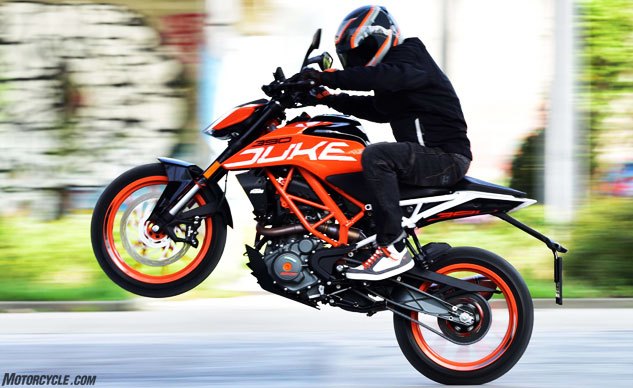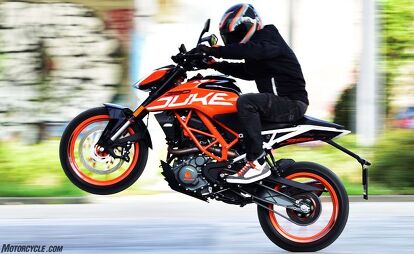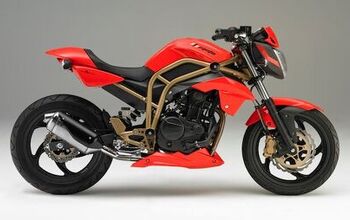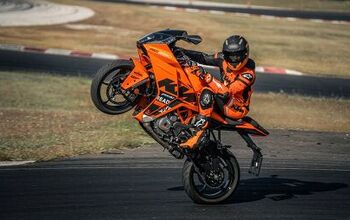2017 KTM 390 Duke Review
The adorably playful puppy of sports roadsters graduates finishing school
The moto market is spoiled for lustful choices in the high-end arena, but creating a desirable motorcycle at a budget price is a more challenging achievement. The KTM 390 Duke has been entertaining us with its unequaled balance of style, performance and value since we first took the terrific little funster for a spin in 2015, and it rightfully earned its place as Best Entry-Level Motorcycle in our annual MOBO awards. For 2017, the little Duke gets even more desirable by offering greater comfort, higher technology and a bit more power.
2017 KTM 390 Duke
| Engine | 19.0/20 |
| Suspension/Handling | 13.5/15 |
| Transmission/Clutch | 8.5/10 |
| Brakes | 9.0/10 |
| Instruments/Controls | 4.75/5 |
| Ergonomics/Comfort | 8.75/10 |
| Appearance/Quality | 9.5/10 |
| Desirability | 8.25/10 |
| Value | 10/10 |
| Overall Score | 91.25/100 |
Best Lightweight/Entry-Level Motorcycle Of 2016
Let’s start with the aspect of a bike that first makes it attractive to a rider – appearance. It’s not easy to spawn a frugal machine that looks expensive, but the 390 Duke pulls off that feat better than any other reasonably priced roadster in recent memory. The sharp creases of its new bodywork yield a bold and contemporary visage, enabling its rider to hold his or her head high at the local bike night.
The Duke’s new face is a split headlight design that roughly mimics that of its large-and-in-charge Super Duke R brother, now incorporating full LED lighting – a first in its class. The orange trellis frame (revised to deliver a 10mm shorter wheelbase and 5mm less trail) underpinning the Duke is visually offset by its white-colored lattice subframe, now a bolt-on design that allows for easier crash repair should you be unfortunate enough to not be saved by the bike’s tremendous agility or its two-channel Bosch ABS system.
The upscale theme continues in the instrument panel, a color TFT display that is another first in its class. It looks expensive, and its 5.2-inch panel remains easy to read thanks to automatic adjustments to ambient light and switching over to a black background in low light. The tach is represented in an analog sweep that changes to red as it nears its 10,000-rpm rev limit. It’s a huge improvement over the mediocre former instruments and also offers KTM’s optional My Ride feature ($25.99) that syncs via Bluetooth with your smartphone to control and display calls and music.
The 390’s agreeable ergonomics gets tweaks for 2017 that are both subtle and significant. The handlebar places the grips a bit forward and slightly higher, and new dogleg levers now feature span adjustments to five positions. Footrests are a bit higher and more rear-set, and their brackets are now made from forged aluminum instead of the previous castings to help prevent cracking that apparently occurred seldomly when thrashed on undeveloped roads in second-world nations. A new seat dramatically improves comfort relative to the previous saddle that felt cheap and unsupportive, but it comes at the cost of increased height. KTM says it sits at a fairly lofty 32.7 inches (up from 31.5), but it feels significantly lower thanks to a narrowish front section that gives legs a convenient straight shot at the ground.
More improvements come from WP, the KTM-owned suspension company. The 390’s previous suspenders were closer to adequate than excellent, so WP stepped up with new components at both ends. The beefy 43mm inverted fork still lacks adjustability but now uses an open-cartridge design apparently able to better accommodate a variety of loads, with rebound- and compression-damping circuits in separate legs. Progressive-wound springs are better able to support chassis pitching while remaining compliant. A new progressive spring also joins the new damper out back, a separate-piston design adjustable only for preload over nine steps of its ramped collar. The suspension performed well under my 150 lbs, but 220-lb Bertrand Gahel from Canada’s Le Guide de la Moto also had praise for it.
The little Duke ushers in ride-by-wire throttle control to the sub-500cc category, a strategy to help the 373cc motor meet Euro 4 emissions regulations. It includes one-touch starting and helps the single-cylinder mill light up quickly, a welcome upgrade from the sometimes-finicky previous version.
The engine receives no internal changes, but a slightly larger airbox and a new exhaust system are purported to help contribute an extra 1.5 lb-ft of midrange torque. This small number may seem insignificant, but it’s an improvement of 5.7% and feels like even more when measured at the ol’ butt dyno. Based on our previous actual dyno measurements, we expect 26 lb-ft of twist at its rear wheel. Horsepower is said to be the same as before, so it’ll likely hit about 40 horses around 9000 rpm. Both those power numbers are significantly more than you’ll find from any sub-400cc streetbike and are enough to coax out wheelies even in second gear.
The Duke’s exhaust system got overhauled for 2017, with rerouted headers and the cat-con behind the cylinder on the left. The system retains a sizable chamber behind the engine but adds a tidy side-exit muffler in front of the Duke’s aluminum swingarm (another unusual item in its class) that completes the conversion to Euro 4 acceptability.
KTM claimed a dry weight of 306 lbs for the original version and 328 lbs for this one. Considering the 2016 weighed about 340 lbs wet, and the new fuel tank (steel, no longer nylon) carries a welcome extra 0.6 gallon to 3.5 gallons, we expect the 2017 edition will scale in around 360 lbs when full of fuel.
Riding the 390 Duke is almost completely delightful. Clutch effort is light, the engine pulls cleanly from low revs, and gearshifts are light. The clutch’s slipper function makes ill-timed or aggressive downshifts nearly foolproof. The Duke excels at squirting through the tight confines of urban traffic, and it has plenty enough power to cruise at 80-per while its counterbalanced engine keeps vibration levels from becoming oppressive. Carving a twisty road is a riot, with responsive steering enabling changes of direction quicker than a border collie while maintaining the stability of a basset hound. It’s truly a wonderful backroad scratcher that flatters its rider.
The least impressive part of the 390 Duke experience is a radiator fan that kicks on just three bars away from its cold reading, whining away as obnoxiously loud as the Buell Ulysses rear cylinder fan. Word from KTM is that its partner, Bajaj, which builds the smaller Dukes in India, wants the fan to come on early so there would be no overheating issues in their hot domestic climate. KTM says it’s working on trying an update for bikes bound for Western markets that would prevent the fan from kicking in until reaching higher temperatures.
But you’ve got to look pretty damn closely to find fault with the new 390 Duke. It’s almost as if KTM took to heart the nits we had to pick with the previous version and refined one of our favorite small-displacement roadsters of all time into something almost debonair, which is quite a feat for a motorcycle that retails for just $5,299. The little Duke has earned the first perfect 10 score I’ve awarded in our Value category.
2017 KTM 390 Duke
+ Highs
- Sensational value
- Sharp appearance
- Punches way above its weight
– Sighs
- Whiny radiator fan
- A few ugly welds
- No 390 Dukes when we were 16
Related Reading
Best Lightweight/Entry-Level Motorcycle Of 2015
2017 KTM 390 Duke Preview
2016 KTM 390 Duke Long-Term Review
Little Tearers Comparison: Honda CB500F vs. KTM 390 Duke
2015 KTM 390 Duke First Ride Review
2017 KTM 390 Duke Specifications | |
|---|---|
| MSRP | $5,299 |
| Engine Type | Single cylinder, 4-stroke |
| Displacement | 373.2 cc |
| Bore/Stroke | 89 / 60 mm |
| Power | 42.9 hp at 9000 rpm (claimed) |
| Torque | 27.3 lb-ft. at 7000 rpm (claimed) |
| Compression Ratio | 12.6:1 |
| Starter/Battery | Electric starter / 12V, 8 Ah |
| Transmission | 6 gears |
| Fuel System | Bosch EFI (throttle body 46 mm) |
| Control | 4 V / DOHC |
| Lubrication | Wet sump |
| Engine Oil | Motorex Formula 4T |
| Primary Drive | 30:80 |
| Final Drive | 15:45 |
| Cooling | Liquid cooling |
| Clutch | PASC slipper clutch, mechanically operated |
| Engine Management | Bosch EMS with RBW |
| Frame | Steel trellis frame, powder coated |
| Subframe | Steel trellis frame, powder coated |
| Handlebar | Steel, tapered, Ø 26 / 22 mm |
| Front Suspension | WP-USD Ø 43 mm, 5.6 inches travel |
| Rear Suspension | WP shock absorber, 5.9 inches travel |
| Front Brake | Four piston, radially mounted caliper, brake disc Ø 320 mm |
| Rear Brake | Single piston, floating caliper, brake disc Ø 230 mm |
| Abs | Bosch 9.1MP Two Channel (disengageable) |
| Front Wheel | Cast aluminum, 3.00 x 17″ |
| Rear Wheel | Cast aluminum, 4.00 x 17″ |
| FrontTire | 110/70 ZR 17 |
| Rear Tire | 150/60 ZR 17 |
| Chain | X-Ring 5/8 x 1/4″ |
| Silencer | Stainless steel primary and aluminum secondary silencer |
| Steering Head Angle | 65° |
| Trail | 3.7 inches |
| Wheel Base | 53.4 ± 0.6 inches |
| Ground Clearance | 7.3 inches |
| Seat Height | 32.7 inches |
| Fuel Tank Capacity | 3.5 gallons / 0.4 gallons reserve |
| Dry Weight | approx. 328 pounds (claimed) |
More by Kevin Duke























































































Comments
Join the conversation
5,200 for this Indian built junk? No thx
Any info on the valve adjustment intervals ? I Know the Yamaha R3 as competition is up there. This sort of information is what's missing in the online world of reviews and becomes relevant at service time.